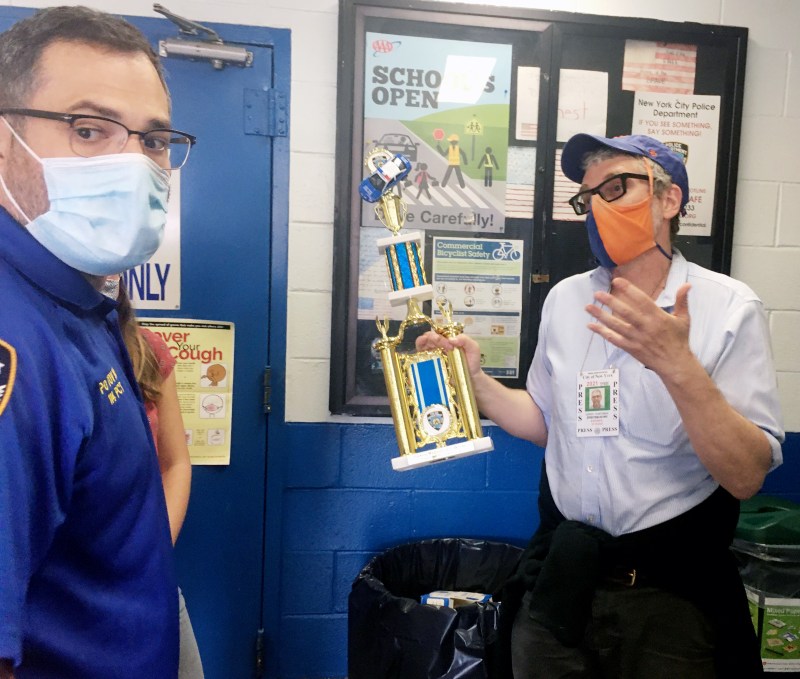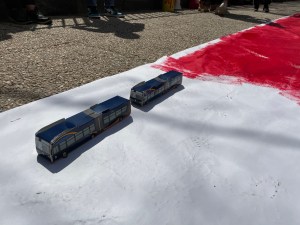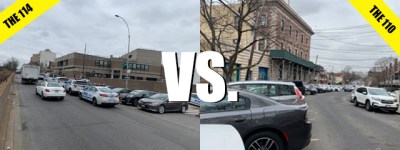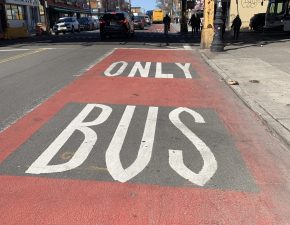March (Parking) Madness Stunner: Capt. Jenkins at the 114 Pct. Won’t Accept Winner’s Loser’s Trophy

Here’s what you can do with your freakin’ trophy.
Officers at the 114th Precinct in Astoria, Queens — winners of this year’s March (Parking) Madness tournament to determine the most-disrespectful station house in town — refused to accept the impressive, custom-made trophy that Streetsblog had commissioned to dishonor honor Capt. Ray Jenkins and his cops.

The trophy was the culmination of a month-long NCAA-style, 14-contest battle (see bracket) pitting Streetsblog readers’ nominations of the precincts where police illegally park in such an egregious fashion that their contempt for their neighbors is clear.
That much is certainly true at the 114th, which won all of its preliminary bouts in relatively easy fashion — even triumphing in the Queens borough final, when Jenkins’s troops were up against the 110th Precinct of Elmhurst, where cops literally leave their squad cars so haphazardly that it looks like the entire neighborhood is some giant’s sandbox.
The April 5 final against the 34th Precinct was a battle for the ages, with the 114th triumphing by adding in an entirely new wrinkle to the precinct’s illegal and dangerous parking: filthy streets ringing the Astoria Boulevard station house.
And when the Streetsblog crew showed up to present the trophy at the Astoria Boulevard station house last week, the cops at the 114th were in rare form. Not only was the 35th Street bridge lined on both sides with police vehicles on the sidewalk, but cars were triple-parked in front of the station house itself, and both side streets were choked with officers’ personal vehicles.
That’s the kind of performance Streetsblog readers (and Astoria residents) expect from a champion.
Here’s a slideshow of our efforts to present Jenkins with the trophy he and his cops so richly deserve:
Inside the building, Streetsblog reporters and editors Julianne Cuba, Dave Colon, Eve Kessler and Gersh Kuntzman tried to make the case that they should be allowed to present Jenkins, or a representative, with the trophy, but Community Affairs Officer Gabriel Tovar was not having it.

“I saw the article,” Tovar said. “You’ve been trolling our page pretty good. But you have to go through DCPI [the NYPD’s press office]. We can’t accept this.” (To be clear, Tovar was professional and polite. To also be clear, Streetsblog had reached out to the NYPD press office days earlier to request an interview with Jenkins, but that request was not responded to. A follow-up was also ignored.)
The failure of the NYPD to even recognize that it has a problem — and our lighthearted attempt to deliver a trophy is just a symbol of that — is part of the reason why Streetsblog conducted the Parking Madness contest in the first place.
It’s a contest built on a simple premise: That the NYPD shows utter contempt for its communities when officers’ cars and department vehicles are illegally parked, double-parked, foolishly parked or combat-parked in front of the station house or on its residential side streets. Such conditions make many blocks around NYPD station houses chaotic, garbage-strewn, dangerous, and appearing to be occupied by a hostile military force that doesn’t care at all about the people around it.
It’s not only a bad look for an agency sworn to serve and protect with “Courtesy, Professionalism and Respect,” but it’s also unsafe.
Anyone who walks, bikes or drives in this city has experienced the sudden feeling of menace whenever approaching a New York City station house, thanks to the way cops park. In the course of our tournament, we saw:
- Cops parked in front of fire hydrants.
- Cops triple-parked.
- Cops leaving cars in crosswalks, curb cuts and in a way that blocks pedestrians or those in wheelchairs.
- Cops who leave their cars in residents’ driveways.
- One block where the police were so aggressive in taking parking from neighbors that residents started deploying their own barricades to block cops from stealing “their” spaces.
Brooklyn Borough President Eric Adams may think illegal parking by cops is just a “New Paltz” problem, but public outrage is growing. In a poll of 591 likely Democratic primary voters, Data For Progress found that 63 percent of New Yorkers (plus or minus 4 percent) oppose cops parking on the sidewalk, while only 29 percent are OK with it.

As part of our preparation for this year’s contest, Streetsblog undertook an exhaustive review of city crash reports on the blocks near and directly in front of NYPD precinct houses. In many cases, protected or painted bike lanes vanish on the roadway directly in front of a station house, which is entirely a result of the NYPD not supporting the Department of Transportation’s efforts to keep cyclists safe.
In other words, a cyclist can be riding, say, westbound on E. 119th Street in Harlem, where there is a painted bike lane and relatively little danger from drivers. When the cyclist crosses Lexington Avenue, the bike lane disappears and suddenly the roadway is filled with dozens of more parked cars, some perpendicular or angled to the sidewalk, some scattered here and there, with squad cars often double-parked in front of the 25th Precinct station house. It’s a chaotic mess that leads to crashes. Here’s what it looks like:

Yes, it’s a mess, but is it more dangerous to drivers and more vulnerable road users? A verifiable yes.
In our study, which covered crashes from from the start of 2018 until the dawn of the pandemic in 2020, we found that on precincts that face a public street:
- 70 precincts had a higher number of crashes on the precinct block than on either of the side streets directly on either side of the station house. Only four precincts in the entire city — the 62nd in Bensonhurst, the 90th in Greenpoint, and the Fifth and 23rd in Manhattan — had fewer crashes on the block in front of the station house.
- The increase in crashes on a precinct block versus the neighboring blocks varies by precinct and borough:
- In Manhattan, the average precinct block had more than double the crashes (118 percent more) than the blocks on either side of the station house.
- In The Bronx, the average precinct block had 75 percent morecrashes than the blocks on either side of the station house.
- In Brooklyn, the average precinct block had more than triple the crashes (204 percent more) than the blocks on either side of the station house.
- In Queens, the average precinct block also had more than triple the crashes (232 percent more) than the blocks on either side of the station house.
- Staten Island had similar numbers, but the results were heavily skewed against the NYPD because one precinct block contains a busy supermarket with a large parking lot, and it is likely that the supermarket bears a disproportionate share of the blame for crashes.
The reason there are so many crashes on precinct blocks is simple: There is so much driving to precinct blocks — and so much chaos on precinct blocks. Both are problems that are easily solved, yet neither Mayor de Blasio nor Police Commissioner Shea want to address.
The city would dramatically reduce police officers’ driving if the state legislature would require police officers — like other city employees — to live in the five boroughs. But Albany is unlikely to take on the police unions — which cherish the privilege of tens of thousands of its members to live outside the city — without strong advocacy of the mayor. As a result, a majority of cops live outside the city — and an overwhelming majority of those cops drive to work every day.
Barring that heavy lift, the mayor could simply deny cops parking placards and properly enforce parking rules around station houses so they start to resemble normal city office buildings rather than the filthy frat houses they have become. The police commissioner could also simply order his cops to shape up.
The main problem is that neither the mayor nor Shea believe there is a problem. (That’s not a surprise; when Streetsblog spent most of 2019 documenting the poor driving records of NYPD officers, the mayor and Shea mostly shrugged it off and failed to suspend any officer’s parking privileges.) When asked about police parking, the mayor has only spoken about the need to create more spaces for cops — which is simply rank foolishness, given that more parking spaces would only encourage more driving and, as we have seen during this tournament, more illegal parking and vehicular bullying.
We asked the NYPD to comment during the tournament, and Sgt. Jessica McRorie sent over this statement: “Commanding officers at locations across the city are always working to better address this condition.”
We think we’ve provided ample evidence that this is not true.





